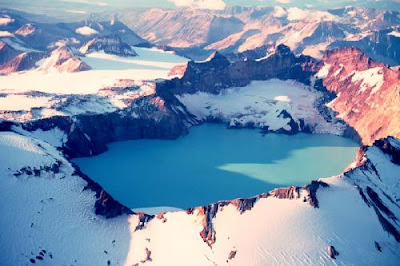
Tuesday, May 29, 2007
Tuesday, May 08, 2007
Wednesday, April 25, 2007
An unusual volcanic eruption re-visited
Recently I heard from an old friend who has moved to Alaska, and the mention of the volcanoes that stand in sight of him reminded me of the enigmatic `Mt.Katmai' eruption. The eruption of Mt. Katmai Alaska began on a day that in later decades would take on greater immortality, June 6th. But this was not 1944, and the D-Day invasion, but 1912. Of course that year boasted another famous event, the sinking of the RMS Titanic after striking an iceberg.
In fact, Katmai's "eruption" (the reason for the qualifier will be related later on) followed less than two months after that disaster, and coupled with the utter remoteness of Alaska at that time, and the minimal loss of life, probably was one of the factors that caused it to be somewhat forgotten despite the scale of its cataclysm. However, the natural wonder that it produced in its aftermath, "The Valley of Ten Thousand Smokes" is somewhat more familiar to the general public, and imminently so to students of geological processes.
Before describing the event, its worthy to notice that it showcased the rise of a very familiar institution of the present -- National Geographic Magazine. Together with the great and devastating eruptions of Mt. Pelee and Mt. Soufriere in the Caribbean in May 1902, the eruption at Katmai and the expedition to chronicle its wonders would open up a whole new phase in exploration, and six years after result in the creation of a new National Monument in 1918, which in 1980 was upgraded to a National Park.
(Note: to return later, it seems I have lost some of my writing, and have to re-post it, arggh. Going to bed now, apologies).
KATMAI Caldera in modern times. The caldera from the collapsed mountain peak is so huge that not only does it contain a lake, but an entire glacier has formed inside it (upper side bank of caldera in view)which feeds the lake. Sporadic underwater eruptions have occurred since 1912.

In fact, Katmai's "eruption" (the reason for the qualifier will be related later on) followed less than two months after that disaster, and coupled with the utter remoteness of Alaska at that time, and the minimal loss of life, probably was one of the factors that caused it to be somewhat forgotten despite the scale of its cataclysm. However, the natural wonder that it produced in its aftermath, "The Valley of Ten Thousand Smokes" is somewhat more familiar to the general public, and imminently so to students of geological processes.
Before describing the event, its worthy to notice that it showcased the rise of a very familiar institution of the present -- National Geographic Magazine. Together with the great and devastating eruptions of Mt. Pelee and Mt. Soufriere in the Caribbean in May 1902, the eruption at Katmai and the expedition to chronicle its wonders would open up a whole new phase in exploration, and six years after result in the creation of a new National Monument in 1918, which in 1980 was upgraded to a National Park.
(Note: to return later, it seems I have lost some of my writing, and have to re-post it, arggh. Going to bed now, apologies).
KATMAI Caldera in modern times. The caldera from the collapsed mountain peak is so huge that not only does it contain a lake, but an entire glacier has formed inside it (upper side bank of caldera in view)which feeds the lake. Sporadic underwater eruptions have occurred since 1912.

Subscribe to:
Comments (Atom)
